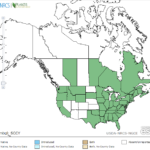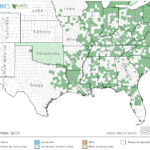Scirpus cyperinus
USDA, NRCS. 2018. The PLANTS Database (http://plants.usda.gov, 28 March 2018). National Plant Data Team, Greensboro, NC 27401-4901 USA.
Illustration: USDA-NRCS PLANTS Database / Britton, N.L., and A. Brown. 1913. An illustrated flora of the northern United States, Canada and the British Possessions. 3 vols. Charles Scribner’s Sons, New York. Vol. 1: 337.
What is Woolgrass (Bulrush)?
Other common spellings and names include: cottongrass bulrush, marsh bulrush, teddybear paws.
Physical Characteristics
Leaves:
- Numerous
- Several leaf-like bracts
- Brownish or reddish brown at base
Flowers:
- Dense, branching cluster
- Somewhat droopy
- 200-500 spikelets
- Spikelets are egg- or elliptical-shaped
- Brown in color
- 0.13-0.25 inches long
- 40-100 flowers per cluster
- Scales elliptic, 0.06-0.08 inches long
- Long, brown bristles
- Blooms Jun – Sep
Fruit:
- One-seeded
- Does not open to release seed when ripe
- About 0.05 inches long
- Whitish in color
- Flattened-triangular in shape
Stem:
- Hollow stem
- 2.75-6.5 feet long
- 0.25-0.5 inches thick at the base
- 0.13-0.16 inches thick at top
Where Does it Grow?
Woolgrass prefers slightly acidic soils and can be found in wet meadows, swamps, and muddy areas.
Pros and Cons of Bulrush
Submerged portions of all aquatic plants provide habitats for many micro and macro invertebrates. These invertebrates in turn are used as food by fish and other wildlife species (e.g. amphibians, reptiles, ducks, etc.). After aquatic plants die, their decomposition by bacteria and fungi provides food (called “detritus”) for many aquatic invertebrates. Seeds of bulrushes are consumed by ducks and other birds; while geese, muskrats, and nutria consume the rhizomes and early shoots.
Woolgrass provides cover for nesting birds and is a larval host for the Dion skipper. Can be used for erosion control and as a buffer against wind and wave action.


